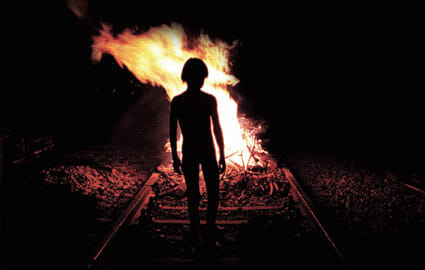Introducing Endless Mode: A New Games & Anime Site from Paste
Michael Haneke is not a familiar name, even to fans of arthouse cinema. His last two films may have starred Isabelle Huppert (La Pianiste) and Juliette Binoche (Code Inconnu), but their difficult subject matter and ambiguous endings didn’t make for the sort of movies that please Amélie fans. And Haneke’s latest opus, Time of the Wolf, isn’t likely to gain him much more of a following, which is a shame.
Reminiscent of the vastly inferior 28 Days Later, Time of the Wolf takes place after some cataclysmic event has occurred. Order has broken down, basic supplies like food and water are unavailable, and masses of people have fled the cities. Huppert plays a mother with two children trying to survive. At first, they’re on their own, which is harrowing enough. But when they join a ragtag collective, they’re exposed to the true horrors of human nature.
Like certain other recent European films (Twentynine Palms, Free Radicals), Time of the Wolf intends to shock its audience. But Haneke’s formal control allows him to accomplish much more. Huppert fans will be slightly disappointed with her relatively minor character. Rather, the early adolescent daughter played by Anais Demoustier assumes center stage. Confronting her own identity, she must also confront the very essence of human nature. What are we like when everything is stripped away? What are we willing to do? What is our responsibility to our family, our fellow human beings?
Haneke also provokes the audience with his narrative choices. There are two situations in which characters accuse someone else of a heinous crime. In one case, the audience is set up by its empathy for certain characters to believe the claim; in the other case, to doubt it. And yet Haneke, through elegant rhyming, forces us to grasp that truth can’t be dependent on whom we like but on its validity. And this is often difficult to determine.
As with his earlier films—The Seventh Continent, Benny’s Video, Funny Games—Haneke’s visual choices and editing style reinforce his rigorous message. Here, it’s the spectacularly dark settings. The blackness of the night scenes is oppressive, and Haneke emphasizes this with takes that go a minute or two without a single cut. The audience sits in the darkness, disoriented and unsure of what’s to come.
This reaches its apex in the film’s final scene, an extraordinary moment in an extraordinary film. Raising fundamental issues of sacrifice and salvation, it challenges the audience to examine its own beliefs and assumptions. And, in the midst of this darkness, a light breaks forth, recalling the famous passage from the Gospel of John: “The light shines in the darkness, and the darkness has not overcome it.”
It should be noted that Time of the Wolf is an exceedingly difficult film to watch and one that isn’t for everyone. Animals are killed on screen, and terrible things are done to humans. Nonetheless, it is one of the most thought-provoking films you’ll see all year and one that finds hope in even the darkest places.
